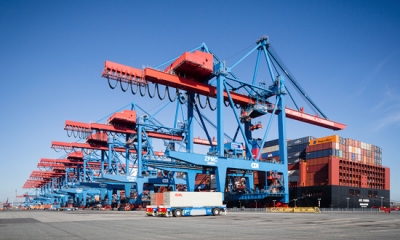HHLA squares up to ultra large containership challenge

Competition is fiercer than ever amongst leading container ports vying to attract the business of today’s three main global alliances as the container sector undergoes a period of unprecedented rationalisation.
But contrary to many experts’ opinions, the commissioning of more and more mega-vessels is not focusing business merely on hub ports, but is also generating new demand in smaller secondary ports and feeder facilities.
According to Stefan Behn, Member of the Executive Board of Hamburger Hafen und Logistik (HHLA), the new alliances are adding more ports to their schedules and smaller ports are also being served on new service loops. “Once ships can get in, they’ll go in,” he told journalists in Hamburg last week. He added that one port call involving a 20,000 teu vessel could well generate transport demand for six feeder vessels, 53 trains and 2,640 trucks
Behn was outlining HHLA’s strategy as new initiatives are introduced to service the latest generation of 20,000 teu-plus vessels. The port and logistics group, 70% owned by the Port of Hamburg with the balance traded on the stock market, operates three container terminals, all of which are being upgraded and expanded to raise both throughput capacity and operating efficiency.
At the highly automated Altenwerder Container Terminal, Germany’ largest container railhead, HHLA is investing in two more tracks, taking the total to nine and increasing annual capacity from 790,000 teu to 930,000 teu. A new ‘train gate’ will automatically record container data on incoming trains as they enter the terminal, replacing the existing manual system and saving space.
Meanwhile new gantry cranes capable of handling boxships with 24 rows of containers across decks are being introduced at the Tollerort and Burchardkai terminals. Although the final details of other expansion initiatives at the Tollerort facility have yet to be decided, the HHLA has already signed up for two, option three, new cranes from Liebherr for the terminal. The gantries will be capable of twin lifts and will have a maximum payload of 63 tonnes.
This contract follows an earlier deal with China’s ZPMC for three new gantries for the Burchardkai terminal. Each of these will have a maximum payload of 110 tonnes and capacity to handle two forty-footers or four twenties simultaneously. Four new storage blocks are to be commissioned to help absorb the peak loads associated with the arrival of mega-ships and will start operating in 2017.
Meanwhile the Nautical Terminal Coordination (NTC), set up by HHLA and Eurogate in October 2014, now manages the logistics of ULCS arrivals and departures, as well as cruise ships and bulk carriers, around the clock. Container ships are constantly monitored from the Straits of Gibraltar across the Bay of Biscay. Ships can be told to speed up or slow down to avoid potential conflicts and logjams in Hamburg or its approaches in the River Elbe.
HEADLINES
- Do shipping markets want Biden or Trump for the win?
- All 18 crew safe after fire on Japanese-owned tanker off Singapore
- Singapore launching $44m co-investment initiative for maritime tech start-ups
- Cosco debuts Global Shipping Industry Chain Cooperation Initiative
- US warns of more shipping sanctions
- China continues seaport consolidation as Dalian offer goes unconditional